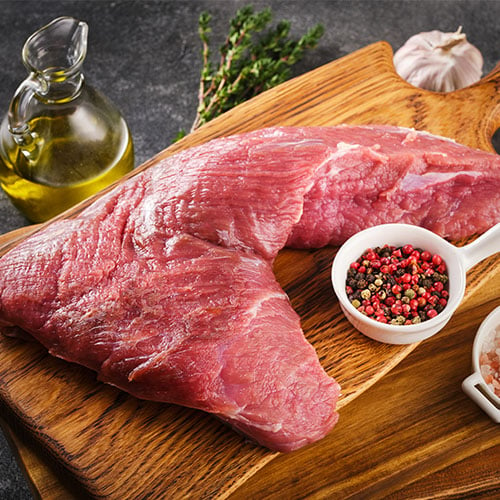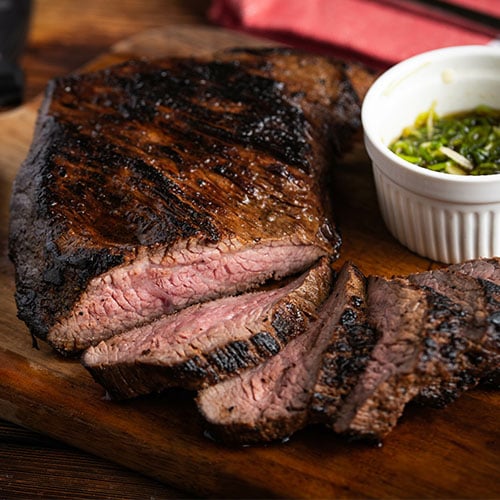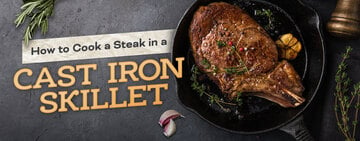Tri-tip is a triangular cut of beef that comes from the bottom sirloin of the cow. Popular in West Coast barbecue culture, tri-tip steak is a versatile and delicious option for grilling or roasting. Whether you're looking to impress guests at your barbecue or expand your steak menu, tri-tip is a fantastic option that wins on flavor and tenderness without breaking the bank.
What Is Tri-Tip?

Named for its distinctive triangular shape, the tri-tip is an easily identifiable beef cut that is still relatively uncommon to find on menus and in stores. While it has been a staple in the Golden State for many years, it has only recently started to gain popularity nationwide for its bold flavor and affordable price. Coming from the bottom sirloin, tri-tip is boneless and boasts a tender texture with a rich, beefy taste sure to satisfy any meat lover's palate. There are two main variations of tri-tip: the tri-tip roast and tri-tip steak. The roast is the complete cut, while the steaks are individual portions sliced from the roast.
The tri-tip cut has a decent marbling throughout the meat, which helps enhance its flavor and juiciness. Because it comes from the sirloin, it's a relatively lean cut of meat best for grilling, roasting, or pan-searing. Tri-tip is a great alternative to pricier steak cuts like ribeye while still delivering on taste and tenderness.
Where Is the Tri-Tip on a Cow?

The tri-tip comes from the loin primal, specifically cut from the bottom sirloin subprimal. It is a leaner cut because it comes from the well-exercised back half of the cow. However, it still boasts a nice amount of marbling, contributing to its flavorful and tender profile when cooked correctly.
Despite being a relatively inexpensive cut of steak, tri-tip can be a rare find at the grocery store since each cow only yields two of them. As a result, you may need to seek out this cut at a local butcher shop or online. Tri-tip is available as a small roast, encompassing the entire triangular cut from the tip of the sirloin, or as individual steaks. These steaks are usually pre-trimmed and weigh approximately 2-3 pounds, while an untrimmed tri-tip can weigh up to 5 pounds and has a substantial fat cap on one side.
Tri-Tip vs Picanha
One cut of meat that tri-tip is often confused with is picanha. Both of these cuts come from the sirloin portion of the cow, but they have some key differences that set them apart. Picanha comes from the top of the cow's rump, specifically the cap muscle surrounding the top sirloin, whereas tri-tip comes from the bottom sirloin. Picanha is sold and cooked with the fat cap intact, adding extra flavor and moisture to the meat. Because it comes from a less-worked part of the cow, picanha is more marbled and tender than tri-tip, resulting in a richer flavor. Being that it's a more prized cut of steak, it is also more expensive.
Unlike picanha, tri-tip is usually trimmed before cooking, making it a leaner option. While it may not have the same level of tenderness as picanha, tri-tip still offers a robust beef flavor that many enjoy at a better price point.
History of Tri-Tip
Back in the day, tri-tip wasn't always in the spotlight. Because a cow only produces two tri-tip cuts, butchers found it challenging to showcase this cut alongside other more popular and abundant steaks. Therefore, it was often ground or cubed for stews.
The turning point for the tri-tip came in the 1950s in Santa Maria, California. This picturesque town is credited with putting tri-tip on the map and elevating its status in the world of steaks and BBQ. The tri-tip quickly became a favorite in Santa Maria and other parts of California, gaining nicknames like "Santa Maria Steak," "California Cut," and "Triangle Steak." Today, the tri-tip steak is a quintessential part of Santa Maria style barbecue, akin to what beef brisket is to Texas barbecue.
What Is Santa Maria Style BBQ?
Even if you're a barbecue enthusiast, you may have never heard of Santa Maria style barbecue. Hailing from California's Central Coast, this lesser-known barbecue region has roots dating back to the 1800s. Santa Maria style barbecue isn't fussy or over-the-top. Instead, it's all about maximizing the beefy flavor of tri-tip (or top-block sirloin) with a few simple ingredients and high-heat cooking. The cut is typically prepared with a simple dry rub mixture of salt, pepper, and garlic salt (and any other herbs or spices you may want to add). It is then slow-roasted over an open cast-iron grill loaded with red oak coals.
The open flame cooking style of Santa Maria style barbecue allows for even cooking and creates a beautiful crust on the steak while keeping the inside tender and juicy. The combination of the dry rub seasoning and the smoky flavor from the red oak coals is a staple of California's culinary heritage, holding its own against traditional, sauce-slathered BBQ.
How to Cook Tri-Tip Steak

Following the right techniques can make all the difference in achieving a flawlessly cooked tri-tip. The best cooking methods for this cut are grilling or roasting it. Both methods allow for a delicious sear on the outside while keeping the meat juicy and tender. Here are some tips to follow when cooking tri-tip:
- Pat the meat dry with paper towels before seasoning it. This helps the seasoning adhere better to the meat and promotes better browning during cooking.
- Allow the seasoned tri-tip steak to sit at room temperature for about an hour to help the meat cook more evenly.
- Start by searing the tri-tip steak on both sides over high heat to develop a flavorful crust. Then, continue cooking it on indirect heat until it reaches the desired level of doneness. Because tri-tip steak is a leaner cut of meat, it is best not to overcook it to prevent it from becoming tough. Aim for a rare to medium level of doneness for the best results.
- Let it rest for at least 10 minutes before slicing and serving. This allows the juices to redistribute inside the meat, ensuring a moist and flavorful outcome.
Tri-tip roasts can be a great addition to your carving station, as they cater to people who prefer different levels of doneness. Thicker portions will stay rare, while the thinner sections will be more medium. Make the tri-tip steak the star of your entree, topped with chimichurri sauce and served with roasted asparagus, garlicky mashed potatoes, and a California Pinot Noir. Or, slice the steak and add it to sandwiches, salads, or pasta dishes.
How to Slice Tri-Tip Steak
When it comes to enjoying a perfectly cooked tri-tip steak, how you slice it can make all the difference. Slicing against the grain is key to achieving a tender and flavorful bite every time. Tri-tip steak contains two different grains due to its unique shape, and typically, the grain changes at the thickest part of the cut. Before cooking your tri-tip, take note of how the grain runs and keep that in mind when it comes time to slice. Improperly sliced tri-tip can turn a beautifully cooked steak into a chewy disappointment so remember to slice against the grain to ensure you're serving up the best possible tri-tip.
Incorporating tri-tip steak into your menu or next BBQ tailgate is a surefire way to elevate your offerings and provide guests with a beef cut they may have never tried. Whether you're serving it as the main course or using it for sandwiches, tri-tip guarantees a memorable dining experience. Its rich, beefy flavor and tenderness make it a standout choice for any occasion.



